No products in the cart.
Established by Srila Jiva Goswami in 1542 in the holy dham of Vrndavan, the Deities of Sri Sri Radha Damodar were given to Srila Jiva Goswami by his guru, Srila Rupa Goswami Prabhupada and have been worshipped here since then. The bhajan kutir and samadhi of Srila Rupa Goswami as well as the samadhis of Srila Jiva Goswami, Krsnadasa Kaviraja Goswami, Bhugarbha Goswami and the bhajan kutir of Srila A. C. Bhaktivedanta Swami Prabhupada are present here also on the temple premises.
Radha Damodar Mandir, Vrindavan;
Sri Sri Radha Damodar Mandir is an ancient temple established by Madhav Gaudiya Sampradaya. It was established by Srila Jiva Goswami in the year 1542 C.E. The deities here were served by Srila Jiva Goswami. Sri Radha Damodar deities were manifested by Srila Rupa Goswami, who gave them to his dear disciple and nephew-Jiva Goswami for service and worship. Later due to the terror of the muslim king Aurengzeb, Sri Radha Damodar were sifted to Jaipur for sometime and when the social conditions became favorable were brought back to Sri Dham Vrindavan in the year 1739 C.E. These deities have been served here since then. In Jaipur however a counterpart (pratibhu) of the deity was installed.
Some devotees are under the impression that the Deities of Radhadamodar in the Radhadamodar Temple in Vrndavan are not the original Deities of Srila Jiva Goswami. Some think that the original Deities now reside in Jaipur. However, this is not a fact.
In 1670, when the Muslim fanatic Aurangazeb invaded Sri Vrndavana, he planned to destroy many temples and deface the Deities there. For this reason the principle Deities of Vraja were moved to the safe confines of the city of Jaipur in Rajasthan under the auspices of the Rajput kings. Most of the Deities remained there, such as Govindadeva, Gopinatha and Madana-mohana.
The Radhadamodar Deities however returned to Vrndavana and have been worshipped there ever since. The Deities that replaced the originals in the temples of Govinda, Gopinatha and Madana-mohana are known as pratibhu-murtis which were installed and worshipped as substitute Deities by the Goswamis of those temples. All pratibhu-murtis are smaller in size than the original Deities installed by the acaryas, but it is worth noting that the Deity of Damodarji in Jaipur is smaller than the Deity in Vrndavana, thus further confirming that the original Deity of Sri Damodarji is in Vrndavana, whereas the pratibhu-murti is being worshipped in Jaipur today.
Before Sri Jiva’s disappearance in 1596, he left his Deities and library in the care of his successor Sri Krishna Dasa, the head pujari. The present sevaites are directly coming in line from his descendants.
Presently along with the Sri Radha Damodar Ji Maharaj there are other deities also being served – namely: Sri Radha Vrindavanchandra Ji, Sri Radha Madhav Ji, Sri Radha Chailachikan Ji, The Giriraj Charan Sila, Sri Gaur Nitai, Shree Jagannath Dev Ji.
One of the oldest holy places in Vrindavan, Sri Radha Damodar temple was built in the year 1524 by Srila Jiva Goswami. Aesthetic in design and impressive architect is very stunning and spiritual in look. People from all across India to see this temple and take blessing of lord Krishna.
Srila Rupa Goswami Prabhupada, the guru, presented the deities which are placed in this great temple to Srila Jiva Goswami. For sometime, these original deities were removed from this temple and sent to Jaipur to protect them. During Aurangzeb rule, when he was derogatorily destroying all temples in Vrindavan, Srila Jiva Goswami took original deities and placed pratibhu-murti in place. Again in 1739, all deities replaced with original and pratibhu-murti are now placed in Jaipur temple. These pratibhu-murti are slightly smaller in size than original deity.
In this highly spirited temple, there is Govardhan Sila which was provided by Lord Krishna to Srila Sanatan Goswami and he bought this Sila to Vrindavan and placed in this great Sri Radha Damodar temple. Many devotees visit this temple to do parikrama everyday to take blessing. During Kartik season, just the day after Diwali, is celebrated as Annakut Mahotsav in which Giriraj Sila is placed out from the main alter (Garbh Graha) for devotees Darshan.
Inside this temple premise, there are situated the samadhis of various prominent people who contributed exclusively in this temple and Vrindavan and devoted their entire life in services of lord. Srila Jiva Goswami, Krishna Das Kaviraj Goswami, Srila Rupa Goswami and Bhugarbha Goswami’s samadhis are built here. It also include samadhis the Bhajan Kutir of Srila Rupa Goswami and many others.
By Road: It is situated at Loi Bazaar in Vrindavan. From Chatikara, head towards Bhaktivedanta Swami Marg and turn left to Parikrama Marg and there is Sri Radha Damodar. There is easy connectivity through autos, rickshaw and other public transport. Rickshaw fare is Rs 10 which is affordable and convenient.
By Rail: The nearest railway station is Mathura.
By Air: The nearest airport is the Agra airport, from where the temple is just 74 kms, that is about 2-hour drive.
This temple Timings: Mangala Aarti 4.30 am; Summer darshan 6.30 am to 12.30 pm, 5.00 pm to 9.30 pm; Winter darshan 7.30 am to 1.00 pm, 4.15 pm to 8.45 pm. During this period major part of the Lord Krishna rituals are performed. Archana, Aarti and Abhisekham are the daily pujas performed.
In this temple, Lord Krishna is offered bhog five times a day and various seva is performed. Most prominent among them are: Mangla Seva, Dhoop Aarti Baalbhog Seva, Sringar Seva, Raajbhog Seva, Sandhya Dhoop Seva, Sandhya Aarti Seva, Shayan Seva, Abhishek Seva, Poshak Seva, 56 Bhog Seva, Bhool Bangla Seva, Mukut Sringar Seva, Sadhu Vaishnav Seva, Gau (cow) Seva, Hari Naam Sankirtan Seva including others. In Mangla Seva, Makhan-Mishri, Kheersa (in clay pot), Ghee and others are offered, Dhop Aarti Baalbhog Seva in which fruits, Makhan, Mishri, dry fruits, Kheechadi Seva and other sweets are offered. Sringar Seva is performed with offering garlands made of fresh flower of season, decorative ornaments and aarti.
Raajbhog Seva is offered with rice, chapati, sweet rice, daal, ghee for aarti and other delicious food. In Sandhya Dhoop Seva, fruits, Mishri, Makhan, dry fruits, kheechadi seva and other sweets including ghee for aarti is offered. Sandhya aarti Seva is performed with aarti. Shayan Seva is performed by offering Puri Chapati, two types of delicious sabji, halwa, sweets, perfume seva and ghee for aarti. During Abhishek Seva, sevak or main priest bath deities with cow milk, curd, ghee, sugar powder, honey and later this is distributed among devotees as Charnamrit. Poshak Seva is performed by offering regular dress, festival dress and night dress to deities. In Sadhu Vaishnav Seva, services are offered to Sadhu or saints and Bhandara for devotees. Aarti is performed seven times a day throughout the year in this temple.
Many festivals are celebrated with enthusiasm and devotion. Some of them are Kathik, Sharad Purnima, Govardhan Puja, Srila Prabhuapad Tirobhav, Gopaastami, Devotthan Ekadasi, Sri Radharani Charan Darshan, Kartik Maharaas Purnima, Vanjuli Mahadwadasi, Srila Jiva Goswami Tirobhav Mahotsav, Sri Radha Damodar Praakatya Utsav, Acharya Sri Gaurachand Goswami Avirbhao, Holi, Sri Gaur Purnima, Chandan Yatra and many other.
One thought on “Radha Damodar Mandir, Vrindavan”
Leave a Reply
You must be logged in to post a comment.



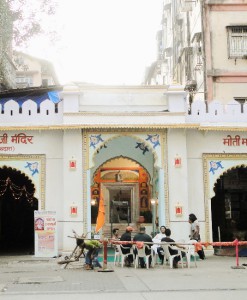
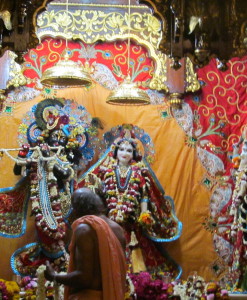
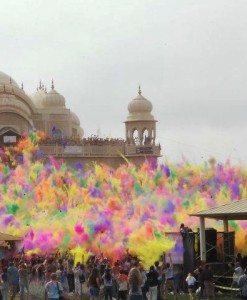
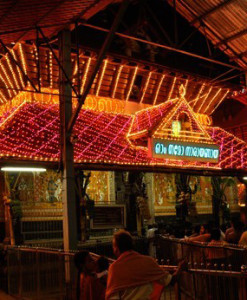
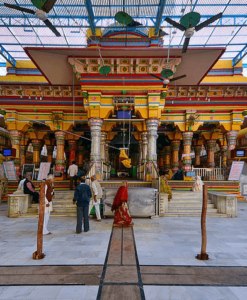
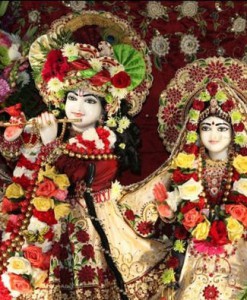
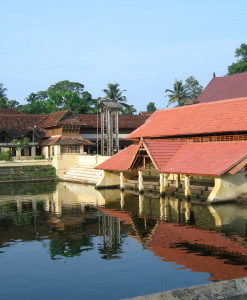
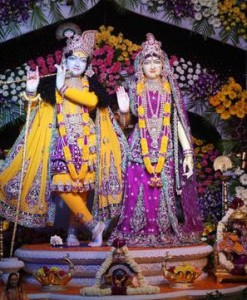
Radhe Radhe